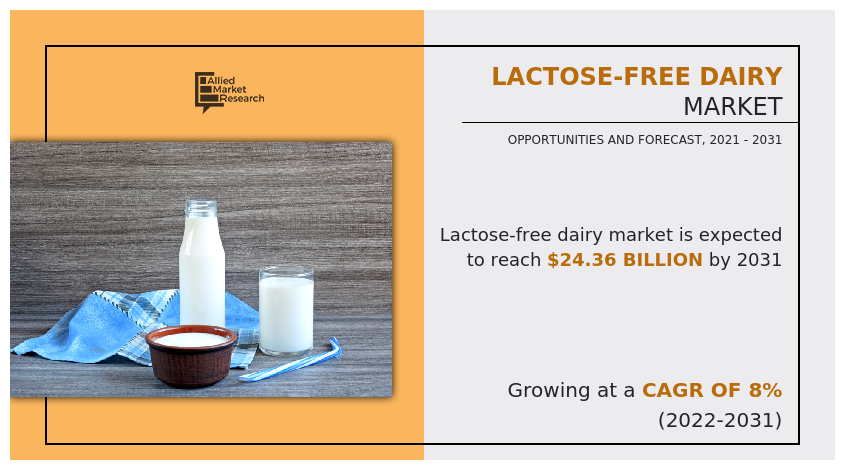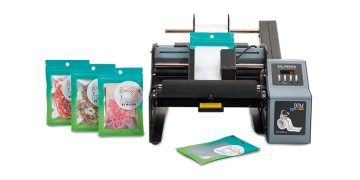Lactose-free milk is a lactose-free commercial milk product. Lactose is a kind of sugar present in milk that causes indigestion in individuals who are lactose intolerant. Lactose-free dairy products are created by blending lactase with ordinary cow’s milk. Lactase is a naturally occurring enzyme in the small intestine that is responsible for breaking down lactose into glucose and galactose. The monosaccharides are easily absorbed in the small intestine and prevent lactose intolerance symptoms from occurring. Lactose-free dairy can give the important elements found in traditional dairy products, such as calcium and vitamins, to persons who cannot digest lactose.
The global lactose-free dairy market is witnessing significant growth, owing to the development of the global processed food industry, increase in consumption of lactose-free dairy and other dairy products by an aging population, and growth in urbanization. In addition, the rise in prevalence of diabetes, obesity, and other health issues; the rise in need for energy with weight management; surge in consumer preference toward sugar-free, lactose-free, and gluten-free flour are some of the major factors anticipated to drive the demand for lactose-free dairy. However, lack of awareness, regarding the benefits of lactose-free dairy products, especially in developing economies; and its high cost compared to other conventional dairy products is anticipated to hamper the lactose-free dairy market growth.
The International Organization for Standardization (ISO), Canadian Food Inspection Agency (CFIA), Food and Drug Administration (FDA), International Dairy Foods Association, World Health Organization (WHO), and European Union (EU) are some of the regulatory authorities present in the dairy market. The surge in concern among people regarding their health due to dairy consumption, the perishability nature of dairy products, and lack of proper storage facilities are some factors that hamper the growth of the lactose-free dairy market. Low-fat and low-cholesterol dairy products are manufactured to meet the requirement of health-conscious people, with innovation in manufacturing techniques of lactose-free dairy products, which in turn provides lactose-free dairy market opportunity for growth.
Gluten-free meals have gained popularity around the world, owing to an increase in gluten allergies and celiac disease, a sickness that causes inflammation in the small intestines and high gluten sensitivity. According to the clinical practice journal of the American Gastroenterological Association, the global prevalence of the celiac disease is 1.4%, with celiac prevalence values of 0.4% in South America, 0.5% in Africa & North America, 0.6% in Asia, and 0.8% in Europe & Oceania. Moreover, other health claims associated with gluten-free products, such as cholesterol management and digestion control, have fueled the curiosity of consumers, resulting in increased sales. A lactose-free dairy product is an effective food solution that is gluten-free and helps to avoid damage to the gut lining, which leads to celiac disease.
The lactose-free dairy market is segmented on the basis of type, form, distribution channel, and region. On the basis of type, the market is categorized into milk, cheese, yogurt, and others. On the basis of form, it is segregated into solid, liquid, and powder. On the basis of distribution channel, it is divided into hypermarkets/supermarkets, convenience stores, online channels, and others. On the basis of region, it is analyzed across North America (the U.S., Canada, and Mexico), Europe (Germany, the UK, France, Italy, Spain, and Rest of Europe), Asia-Pacific (China, India, Japan, Australia, South Korea and Rest of Asia-Pacific), and LAMEA (Brazil, Turkey, South Africa, Argentina, and Rest of LAMEA).
The players operating in the global lactose-free dairy industry have adopted various developmental strategies to increase their lactose-free dairy market share, lactose-free dairy market size increase profitability, and remain competitive in the market. The key players profiled in this report include Arla Foods amba, Danone S.A., General Mills, Inc., Gujrat Cooperative Milk Marketing Federation (AMUL), Johnson & Johnson Services, Inc., Lifeway Foods, Inc., Nestle S.A., Organic Valley, Saputo, Inc., and Smithfoods, Inc. Some of the additional companies in the lactose-free dairy business are Agri Mark, Inc., Fonterra Group, Lala U.S., The Kraft Heinz Group, Prairie Farms Dairy, The Coca-Cola Company, and others.




















